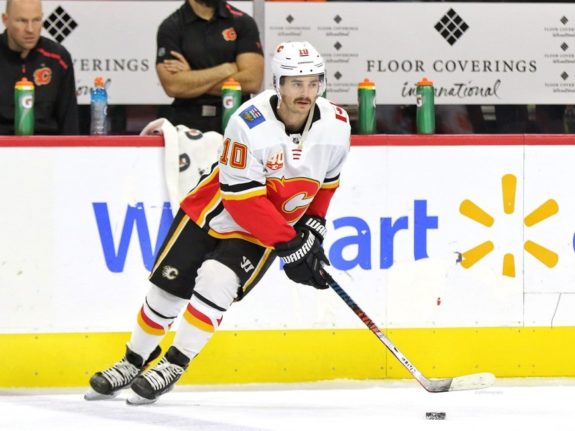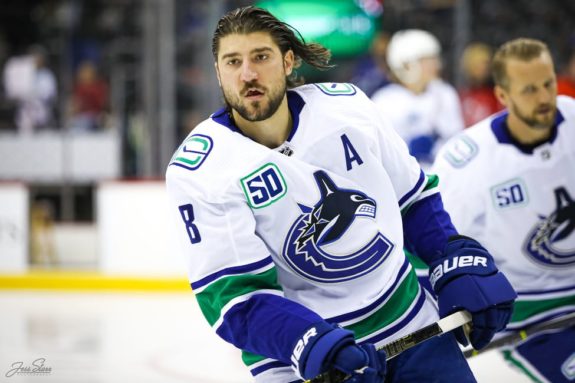In 2005, the NHL made the decision to establish a salary cap. Before that, teams could spend whatever they wanted on players. Of course, this was a huge disadvantage for small-market or unappealing franchises as they had an extremely tough time luring free agents or convincing their players to sign extensions. The disparity led to the implementation of a $39 million cap limit per team.
Today, the cap limit has increased dramatically. For the 2019-20 season, it was $81.5 million and would have increased again in 2020-21 if not for the lost revenue due to COVID-19. Instead, the salary cap will remain at the same $81.5 million for next season, which has put some teams in a tough situation, that now have to manage the loss of anticipated cap space.
Thankfully, the flat salary cap hasn’t overly affected the Calgary Flames, mainly because they don’t have many bad contracts. In fact, cap hits like Johnny Gaudreau’s $6.75 million, Sean Monahan’s $6.375 million, and Elias Lindholm’s $4.85 million are some of the most team-friendly deals in the NHL. Still, like every other team, the Flames have some contracts that are less desirable. Here are their three worst for the 2020-21 season.
1. Milan Lucic
$5.25 Million Average Annual Value (AAV)
While the Flames don’t have many bad contracts on their hands, they do have one of the worst in the league with Milan Lucic. The 32-year-old makes $6 million per season, but the Edmonton Oilers agreed to eat a portion of that total when they traded him during the 2019 offseason for James Neal.
Trading for a player with a big cap hit and diminishing skills like Lucic didn’t seem like a great idea, but the deal has mostly been a success for the Flames. They traded out another poor contract in Neal, and grabbed a physical player which they desperately needed in Lucic. He is also a locker room favorite with a Stanley Cup championship on his resume.

Still, he gets paid like a top-six forward and only out up 20 points last season, which wasn’t an anomaly, as he had the same totals in 2018-19 with the Oilers and has not hit the 40-point mark since the 2016-17 season. He is not the dominant power forward he once was, and has turned into a liability due to his cap hit. To make matters worse, his deal still has three years remaining.
2. Derek Ryan
$3.13 Million AAV
Derek Ryan’s path to the NHL has been spectacular. The 33-year-old didn’t make his NHL debut until the age of 29. Before that, he spent four seasons playing for the University of Alberta Golden Bears, followed by three seasons in Austria and one in the SHL. He finally signed his first NHL contract with the Carolina Hurricanes before the 2015-16 season, and despite spending most of that season in the AHL, he played his first six NHL games.

He spent the next two seasons with the Hurricanes before signing a three-year, $9.375 million deal with the Flames. His first season was a success, posting a career-high in points with 38, and he provided the secondary scoring that management had expected from their third-line centre. The 2019-20 season wasn’t that different in terms of production, as he had 29 points in 68 games played, which translates to roughly 35 points in a full 82-game schedule.
Make no mistake, Ryan is still a valuable NHL player. However, given the Flames’ roster, he isn’t really needed, especially considering the money he is making. Last season he was mainly used on the fourth line, and that will likely continue in 2020-21. That, paired with the fact he will be 34 by the time the season begins, makes his contract one of the worst on the Flames.
3. Chris Tanev
$4.5 Million AAV
This final one is nitpicking a bit, but the Flames don’t have many bad contracts to choose from. Though Tanev has not yet played a game in a Flames jersey, I was critical of this signing when it happened, partly because of the cap hit but even more so the term. Of course, we’re only discussing the 2020-21 season here, but this deal could cause headaches as soon as this season.

If Tanev is able to stay healthy and remain in the lineup this season, his contract will not be a problem. That is a big ask however, given his injury riddled past. The soon to be 31-year-old has appeared in 70 games just once over his eight-season NHL career. Given his rugged style, along with his age and injury history, making it through the season doesn’t seem promising.
When Tanev is in the lineup, he will be extremely valuable to the Flames, especially given the number of defencemen they lost via free agency. He is a very good player and will be a great mentor to the young Flames, Juuso Valimaki in particular who he could be paired with this season. Unfortunately, Tanev’s cap hit is a pretty big one for a player who may spend his share of time on injured reserve.
Good Value Contracts
As mentioned above, the Flames have great bargain contracts with Gaudreau, Monahan, and Lindholm and, on top of that, they have many others signed to very fair deals. Teams who are made up of contracts like these are generally among the league’s most successful teams, and it proves why the Flames have been competitive over the last few years.